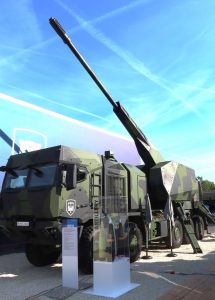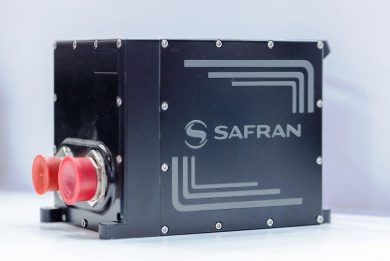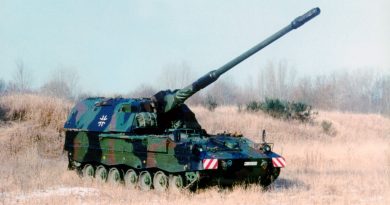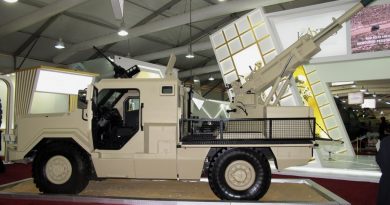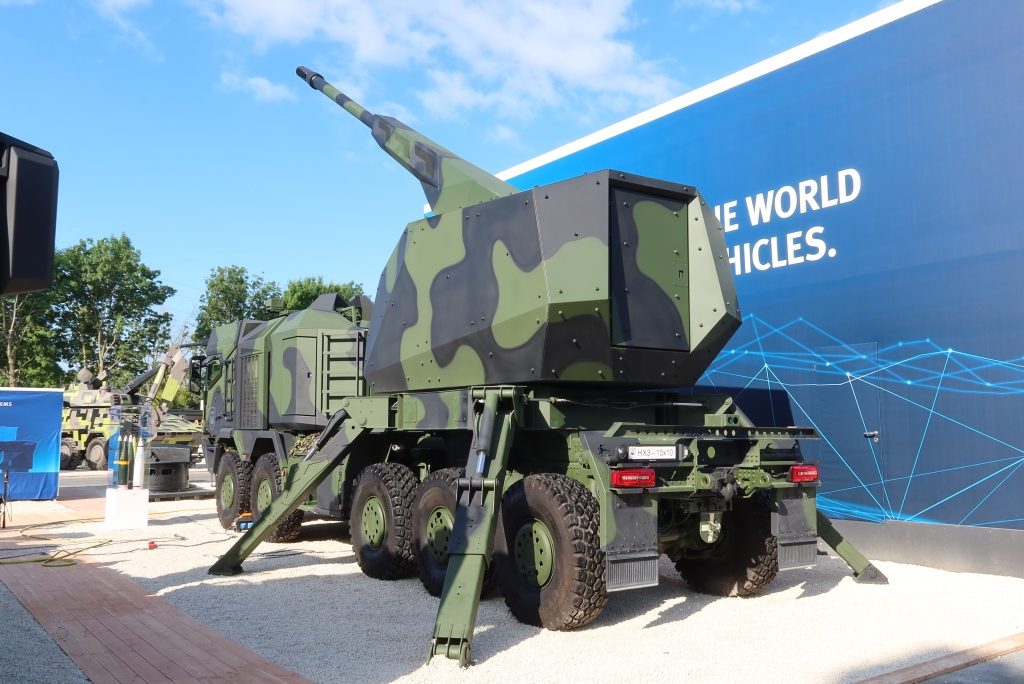
A long-range truck-based artillery effector by Rheinmetall
Visiting the Unterlüß premises means witnessing the manufacturing of some of the key elements of the new Rheinmetall artillery system that is being proposed to the Bundeswehr and, of course, to potential export customers.
The remaining key element, the 10×10 truck chassis, is produced by Rheinmetall MAN Military Vehicles (RMMV), the joint venture between Rheinmetall (51%) and MAN (49%), specialised in trucks design and production, from white fleet trucks to fully militarised tactical trucks, which main production facility is based in Vienna.
The new artillery system is based on the new HX3 truck chassis, the new family of vehicles ensuring better protection, better ergonomics, a new electronic architecture, simpler human-machine interface, increased stowage space for soldiers’ equipment, as well as innovative mechanical solutions. The new Euro 5 engine is fully multifuel and can therefore employ either diesel fuel or F34 jet fuel, a key capability when operating downrange. A Euro 6 engine is also available, however in that case the silencer must be replaced to allow it using the F34.
As said a key issue in the design phase was protection, both ballistic and against blast. Customers can select their preferred protection solution, maximum level remaining classified. Rheinmetall inaugurated the new Unterlüß protected cabin assembly hall in 2014, and since then in late April this year 1,380 such cabins had been produced. A new welding robot was acquired, being the only one in Germany capable to weld ballistic steel, according to the company. The robot is used to weld the main parts of the cabin, the structure, the floor panel, the rear panel and the doors, while smaller items are welded by hand, which is considered more cost effective. Welding is checked using paint, UV rays and magnetron, faulted welding being restored by hand. Once finished the most protected cabin weighs around 2,200 kg, the Rheinmetall Unterlüß plant being able to produce eight cabins per week.
The Rheinmetall Weapons & Munitions (RWM) plant is also in charge of the automated artillery turret that will equip the 10×10 HX3 in the self-propelled artillery version. At Eurosatory the company exhibits the truck with a mock-up turret, as during the show the real demonstrator is being assembled at Unterlüß, EDR On-Line was told. Increasing the range was a key requirement, hence the development of a 60-calibre barrel, which means a 9.3 meters long one. The Unterlüß plant is the one where all 120 mm and 155 mm barrels are produced, the average time since the raw barrel coming from Buderus, a company based in Wetzlar, arrives at the Rheinmetall facility till it is ready to be sent to KMW in Munich, where both the Leopard 2 and the PzH 2000 are assembled, is around six months. The production is made of 24 steps, however the long time is not due to machining but to the resting time between operations, which allows tensions in the materiel to decrease. To give an idea of the precision work involved in barrels production, in a 120 mm 55-calibre barrel, which means a 6.6 meters length, the tolerance on the centre of the bore at the breech end and at the muzzle end must be lower than 0.08 mm. Until now the longest barrel produced was that of the PzH 2000, slightly over 8 meters, however the new 60-calibre artillery barrel requires new tools to be produced, therefore RWM has recently installed new machines. Among those the one used for rifling; in the past the barrel was kept still, the rifling being made by rotating tools that were machining the inside of the barrel. The new grooving machine works with the opposite principle, machining tools remaining fix while it is the barrel that rotates. According to Rheinmetall the new gun will be able to shoot 155 mm boattail, base bleed or V-LAP projectiles at over 75 km, new long-range rounds allowing reaching targets at even greater distances. More than one 60-calibre barrel could be seen on the production line, at different stage of completion, the company aiming to start the testing of the whole system in late 2022.
When dealing with a wheeled vehicle fitted with an artillery system, recoil forces remain an issue. The HX3 10×10 is fitted with hydropneumatic suspensions that can be blocked, and RMMV has carried out extensive simulation; results showed, according to company representatives, that no outriggers would be needed in most situations, however until now firings were carried out with a standard 52 calibre barrel which provides the same range of the PzH 2000. However Rheinmetall has already launched the study for the L52A1 gun, which will have a higher chamber pressure and a new breach, and will allow an extra 5 km range up to 68 km, the L60 gun further increasing the reach up to 80 km. EDR On-Line understood that outriggers will be fitted to the truck chassis, and used only when the howitzer will fire at some elevation, with maximum charge, and at some critical traverse angles; the turret rotates on 360° and can fire at any traverse angle, the elevation arc being -2°/+70° . EDR On-Line was also told that during off-road movement suspensions tend to be submitted to a higher stress compared to that generated by firing. However RWM and RMMV engineers are awaiting firing tests to confirm their assumptions.
The German customer requirement asks for 40 ready to fire rounds, therefore the ammunition and charges magazine linked to the automatic loading system contains exactly that number of rounds. A resupply ammunition package can be carried on board the truck (the chassis ensures a 5 tonnes extra load capacity), the two crew members being able to reload the automatic loading system through a chute at the back of the turret. Each gun battery will of course include a number of reloading trucks, possibly HX3 8×8 to maintain the same level of mobility and protection of the howitzer; these might be fitted with the fully automatic Automated Load Handling System (ALHS) that would contribute to reduce manpower needs.
As the turret will be fully automatic, the crew is reduced to only two people, who operate from the Level 3/3b protected cabin, the fire control system computer linked to upper echelons being installed in the same cabin, firing data being then fed into the turret remotely. Deployment time is under 20 seconds. The overall combat mass of the system is 47 tonnes, a 5 tonnes growth margin allowing for extra ammunition to be carried, standard configuration carrying 40 rounds and 192 modular charges. It is 13.4 meters long, 2.9 meters wide and 3.6 meters wide: it fits into the rail-loading gauge and can be transported on board a C-17 class aircraft. On road it can reach 100 km/h and has a 700 km range. Rheinmetall is actively proposing its new artillery solution not only to Germany, which according to recent information should look for 120 wheeled howitzers, but also to the United Kingdom the British Army planning to acquire 116 new artillery systems to replace legacy AS90s within the Mobile Fires Platform programme that aims at an Initial Operating Capability in 2029, and to Hungary, which has become the launch customer for the company KF41 infantry fighting vehicle, the same chassis being also used in the air defence role, fitted with Rheinmetall Air Defence SkyRanger 30.
Beside the artillery solution, RMMV is considering various uses for its new HX3. According to the company not only artillery but also tactical bridging is moving away from tracks towards wheels, a 10×10 truck version fitted with a quick deployable bridge being one possible variant, the five-axle version of the truck being also considered for carrying huge radars, such as counter-battery ones, recovery systems, minelaying systems, as well as rocket artillery, while four-axle configuration is better suited for air defence solutions. Beside the aforementioned improvements, the HX3 also provided higher on-board power availability; while the HX2 series was fitted with a standard 120 A alternator, a 180 A being available as option, in the HX3 the latter is the standard fit, a 360 A alternator being proposed when the truck must be equipped with power-hungry systems.
Photos by P. Valpolini

